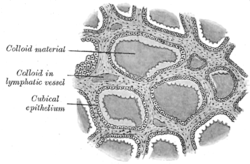Simple cuboidal epithelium
| Simple cuboidal epithelium | |
|---|---|
 Simple cuboidal epithelium in the pig kidney. The surfaces of the large and small collecting ducts (a and b), the circular structures, are surrounded by the simple cuboidal epithelium. | |
| Identifiers | |
| TH | H2.00.02.0.02019 |
| FMA | 45566 |
| This article is one of a series on |
| Epithelia |
|---|
| Squamous epithelial cell |
| Columnar epithelial cell |
| Cuboidal epithelial cell |
| Specialised epithelia |
|
| Other |
Simple cuboidal epithelium is a type of epithelium that consists of a single layer of cuboidal (cube-like) cells. These cuboidal cells have large, spherical and central nuclei.
Simple cuboidal epithelia are found on the surface of ovaries, the lining of nephrons, the walls of the renal tubules, and parts of the eye and thyroid.
On these surfaces, the cells perform secretion and absorption.
Location
Simple cuboidal cells are also found in kidney tubules, glandular ducts, ovaries, and the thyroid gland. Simple cuboidal cells are found in single rows with their spherical nuclei in the center of the cells and are directly attached to the basal surface. Simple ciliated cuboidal cells are also present in the respiratory bronchioles
Function

These cells provide protection and may be active (pumping material in or out of the lumen) or passive, depending on the location and cellular specialization.
Simple cuboidal epithelium commonly differentiates to form the secretory and duct portions of glands.[1] They also constitute the germinal epithelium which covers the ovary (but does not contribute to ovum production) and the internal walls of the seminiferous tubules in the male testes. These cells offer some protection and function in absorption and secretion.
References
- ↑ Pratt, Rebecca. "Simple Cuboidal Epithelium". AnatomyOne. Amirsys, Inc. Retrieved 2012-09-28.
External links
- Histology at KUMC epithel-epith03 "Thyroid gland" (Simple cuboidal)